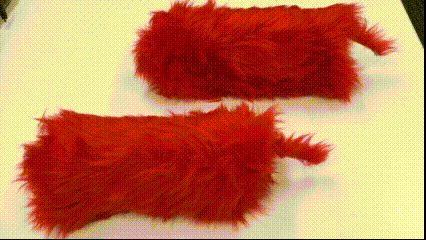Tangled Tails

Introduction
On a planet different from Earth, there lives a creature called tangled tails that has a mysterious characteristic—the extension and contraction of their tails synchronize between individuals. For example, if an older brother’s tail extends, the younger brother’s also extends; if the younger brother retracts his tail, the older brother’s also retracts. What’s more remarkable is that no matter how far apart the brothers are, the timing of their tails’ movements is perfectly synchronized without any delay.
Millions years later, a two-legged tool-wielding species emerged. In time, these upright creatures noticed the unique property of the tangled tails and began domesticating them for various purposes.
This work is a science/speculative fiction piece that explores what kind of civilization might develop in an environment where such creatures exist.

What is Tangled Tails?
Tangled Tails are moving plush toys modeled after fictional creatures. They have tails that extend and contract in synchronization through wireless LAN, and all Tangled Tails belonging to the same group maintain the same tail length.

The tails are approximately 10 cm long and can be extended or retracted by hand. The length is measured and this information is transmitted to synchronized individuals. The receiving individuals adjust their tail length using motors, allowing the length information to be transmitted accurately.
Usage
Transmitting length
Using a Tangled Tail’s tail, you can measure lengths up to 10 cm. This length is immediately transmitted to other synchronized Tangled Tails, eliminating the need to convert the length into numerical symbols for recording or transmission.
If you’ve previously shared information about what length you’re measuring, you can instantly transmit length information between remote locations.
For example, if you take a Tangled Tail to a DIY shop and have your family member measure the size of a light bulb socket or the length of required nails with its paired Tangled Tail at home, you can purchase the appropriate bulb or nails. This makes it possible to transmit information without having to numerically record the length or email the measurements.
Transmitting Other Quantities
Information other than length can also be transmitted in the same way, as long as the quantity can be converted to length. For instance, using a spring scale mechanism, you can transmit weight information, or with a mercury thermometer, you can transmit temperature.
Transmitting Commands and Information
For example, by dividing the tail’s length into five segments and marking each one, you could link different pieces of information to each segment, making it possible to transmit five different types of information. This works on the same principle as the hydraulic telegraph that was actually used in ancient Greece. Since there are historical examples of it being used to communicate enemy attacks in ancient Greece, Tangled Tails could be employed for similar messenger duties.

Communication Without Symbols
The transmission of quantities provided by Tangled Tails does not involve the process of symbolization.
In our civilization, the transmission of quantities such as length is accomplished by measuring the quantity, converting it to numerical values, and recording it using symbols like letters. This process is called “discretization” or “digitization”.
The advantages of converting to numerical values are:
- It enables transmission to remote locations in a form that is less susceptible to corruption
- It allows information to be preserved for the future
These two characteristics have enabled information and knowledge to circulate widely in society, greatly advancing our civilization. For example, recording the movements of stars and disseminating the knowledge gained from years of accumulated data throughout the country to benefit everyday life was done through writing. As numerous activities were digitized, symbolized, and recorded, civilization progressed continuously.
The “direct transmission of quantities” that Tangled Tails provide is a means of transmission that our civilization never had. This project aims to highlight the unique characteristics of our civilization by considering what path human civilization might have taken if we had acquired a way to directly transmit “length” as a quantity to people without digitizing and recording it.
The usage examples shown above prioritize clarity and implicitly assume the combined use of symbolic information sharing. However, the system we’ve implemented was developed to conduct a thought experiment: if communication using Tangled Tails became widespread before the development of symbols, what kind of symbol system might evolve?
Communication forms similar to those mediated by Tangled Tails might include talking drums or whistled languages (such as Silbo). If we use these as references, we can imagine that Tangled Tail communication would develop in a way that follows the development of oral language. However, it remains unclear how rich an expressive power length-based expression could achieve. This is our current research question.
Implementation

Tangled Tails exchange length information between individuals using MQTT communication. Therefore, strictly speaking, numerical data is being exchanged behind the scenes. However, these discretized numerical values are hidden from users and are not consciously perceived.
The current implementation uses a Raspberry Pi 3 Model B for wireless network connection and motor slider control. We also use an Arduino as an ADC (Analog-to-Digital Converter). By utilizing mobile WiFi, they can be connected anywhere, making it possible to use them simultaneously in different locations, such as at home and in a furniture store.
The Tangled Tails themselves provide absolutely no function other than length synchronization. Information about when to communicate or what length is being synchronized needs to be conveyed through separate channels.
Related Work
Ishii et al.’s “Handscape” is a measuring tape-type device that immediately sends digitized information to a computer when measuring length, recording it automatically. This allows the person taking the measurement to record accurate dimensions without directly checking the numerical value representing that length. In this case, the information accumulated in the computer becomes symbolized.
Watanabe et al.’s “LengthPrinter” was proposed as a printer that converts numerical values recorded on the Web or computers into physical lengths. While the outputted “length” is a non-symbolic entity, the information needed to produce it utilizes numerical values that are recorded somewhere.
Tangled Tails use length as both input and output, with synchronized input and output. With synchronized input and output, “input” and “output” become indistinguishable and difficult to separate. Ishii et al. demonstrated with “inTouch” that this form of communication differs in nature from verbal communication.
Onishi et al. are advancing research on bilateral robots that enable mutual interaction of haptic sensations across remote locations. While Tangled Tails focus specifically on sharing length and ignore the impact of latency in remote communication, Onishi et al. point out that latency issues cannot be ignored when considering haptic sharing, and have proposed methods to solve this.
Part of the concept regarding delay-free remote communication in the Tangled Tails narrative incorporates the idea of “philotic connections” featured in Orson Scott Card’s “Enderverse” series, beginning with “Ender’s Game.”
Additionally, the name “tangled tails” plays on Lewis Carroll’s “A Tangled Tale” and the concept of “quantum entanglement,” combined with a reference to “tails.”
Story
This is a tale of a star different from Earth.
Long ago, when there were no creatures on this star that used tools or spoke languages.
In the harsh world of survival of the fittest, the only evolutionary paths for small animals were either to leave many offspring or to develop abilities to flee or hide, extending their survival as long as possible. Many species sought the optimal balance between these two choices, shifting back and forth through genetic diversity.
Among these small creatures, there was a species that chose what would seem to us a very unusual survival strategy.
Somewhat resembling Earth’s cats or rabbits, they had developed the skill of manipulating their long tails to escape predators even on uneven, unstable snow fields in extremely cold regions. However, when the planet entered an ice age, their tails, normally dangling outside their bodies, became a factor that drained body heat, threatening the species’ survival. Eventually, those who could store their tails inside their bodies during normal times and extend them only when pursued by enemies adapted to the environmental changes and survived. However, extending the tail quickly in emergencies was structurally difficult for their bodies, and their numbers gradually dwindled.
Then, as if by some twist of fate, a group of individuals appeared who had acquired a special ability through sudden mutation. When one tried to escape from an enemy by extending its tail, the tails of all its blood relatives would also extend. Thanks to this, even if the first individual encountered by an enemy was caught, its relatives could sense danger from their extending tails, quickly shift to escape mode, and increase their chances of getting away.
So far, exactly how they synchronize the extension and retraction of their tails remains unclear. In the polar regions of this star, where blizzards constantly rage, vocalizations are almost useless, and visibility is severely limited. The only thing that can be said with certainty is that no matter how far apart they were, their tails’ extensions and retractions synchronized without the slightest delay.
If science were to develop sufficiently on this star, research into this phenomenon might have led to theoretical clarification of “quantum entanglement,” eventually promoting the establishment of “philotic physics,” or perhaps paving the way for faster-than-light communication.
By the time the ice age ended, their numbers had greatly increased. As the cold eased and the environment changed, the necessity for tail synchronization seemed to diminish, but surprisingly, it continued to play a role in species survival in an unexpected way. During breeding season, males pursue and mount females to mate, but between closely related males and females, when a male extended his tail to chase a female, the female’s tail would also extend, making it extremely difficult for the male to catch her. This greatly reduced the likelihood of inbreeding, ensuring the species’ continued survival.
Now, after another long period of time had passed, a species appeared on this star that had gained the freedom of both hands by learning to walk on two feet. They quickly mastered tools and were gaining a foothold in transitioning from a hunter-gatherer society to an agricultural one. For convenience, we’ll call them “Humans,” but what the Humans noticed were the small animals that synchronized the extension and retraction of their tails. Since it’s unclear what the Humans called these small animals, we’ll refer to them here as “tangled tails.”
Initially, Humans merely enjoyed watching how pulling or pushing the tail of one captured tangled tail would cause others’ tails to extend or contract in response. But soon they thought of practical applications. Someone discovered that if two people each carried tangled tails that were blood relatives, one person could signal the other without making a sound by pulling the tail of their tangled tail. This proved immensely useful during group hunts.
The uses of tangled tails were not limited to hunting. Everyone quickly understood that they were useful for conveying “length.” They could communicate the size of a caught fish to the settlement or relay the size of needed building materials from a construction site to a quarry. These creatures became indispensable to Human life, allowing instant transmission of information without relying on memory.
Eventually, domesticated tangled tails were selectively bred, leading to the creation of tangled tails with longer tails. As tribes grew larger, they raised multiple blood-related groups of tangled tails, exchanging complex information that increased hunting success rates, improved the efficiency of collaborative work, and allowed them to prosper further.
Anyone observing the history of this star might have thought their society would continue to develop sustainably, but the society that relied on tangled tails did not develop into anything more advanced and was eventually consumed by waves of environmental change. Since they never developed a culture of recording on clay tablets or wooden slips, they left no record for posterity of what they thought or what activities they engaged in.
After the Humans disappeared, the traits of the domesticated tangled tails, which had been barely maintained through coexistence with Humans, quickly vanished from the tangled tails that returned to the wild.
The rescue of a pair of tangled tails was pure luck. Going forward, we hope to study their ecology in detail while uncovering the image of the now-lost civilization that utilized tangled tails.